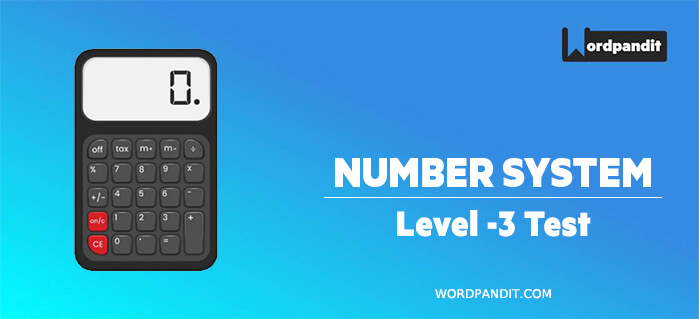- This is an assessment test.
- To draw maximum benefit, study the concepts for the topic concerned.
- Kindly take the tests in this series with a pre-defined schedule.
Number System: Level 3 Test -3
Congratulations - you have completed Number System: Level 3 Test -3.You scored %%SCORE%% out of %%TOTAL%%.You correct answer percentage: %%PERCENTAGE%% .Your performance has been rated as %%RATING%%
Your answers are highlighted below.
Question 1 |
The pages of a book are numbered 0, 1, 2 … upto M, M>0. There are four categories of instructions that direct a person in positioning the book at a page. The instruction types and their meanings are:1. OPEN: Position the book at page No. 12. CLOSE: Position the book at page No. 03. FORWARD, n: From the current page move forward by n pages; if, in this process, page number M is reached, stop at M.4. BACKWARD, n: From the current page, move backward by n pages; if in this process, page number 0 is reached, stop at page number 0.In each of the following questions, you will find a sequence of instructions formed from the above categories. In each case, let n1 be the page number before the instructions are executed and n2 be the page number at which the book is positioned after the instructions are executed.FORWARD, 25 ; BACKWARD, 10. Which of the following statements is true?
n1=n2 if M=10 and n1=0 | |
M=20 provided n1>0 | |
n1>30 provided M=900 | |
n1=37 provided M=25 |
Question 1 Explanation:
Now read the statements carefully from the given instructions:
FORWARD 25, means 25 steps i.e. from page number 1 to 25 and the backward means move back 10 steps, from page number 1 to 25 and the backward means move back 10 steps now to here the right option come to the answer options i.e. 2nd cannot be the answer because if we move 25 forward and 10 backward then the value of M cannot be 20 like this the other options ruled out but as we move on the first option we come to know that n1=n2 =0 and value of M is 10 i.e. n2-n1 = 15, (if M – n1> 25) and n2 = M – 10 (if M – n1 < 25). The only option that satisfies this is option (a). So if M = 10 and n1 = 0. Then M – n1 < 25 and so n2 = 10 – 10 = 0. Hence, n1=n2
Question 2 |
The pages of a book are numbered 0, 1, 2 … upto M, M>0. There are four categories of instructions that direct a person in positioning the book at a page. The instruction types and their meanings are:1. OPEN: Position the book at page No. 1
2. CLOSE: Position the book at page No. 0
3. FORWARD, n: From the current page move forward by n pages; if, in this process, page number M is reached, stop at M.
4. BACKWARD, n: From the current page, move backward by n pages; if in this process, page number 0 is reached, stop at page number 0.In each of the following questions, you will find a sequence of instructions formed from the above categories. In each case, let n1 be the page number before the instructions are executed and n2 be the page number at which the book is positioned after the instructions are executed.BACKWARD, 5; FORWARD, 5. Which of the following statements is true about the above set of instructions?
n1=n2 provided n1 ≥ 5 | |
n1=n2 provided n1>0 | |
n2=5 provided M>0 | |
n1>n2 provided M>0 |
Question 2 Explanation:
It is like as the previous question now given is BACKWARD, 5; FORWARD, 5 it will lead to the value of M is 0 because ni=n2 , i.e one thing is clear that the answer would be 1 or 2 now the next condition is given is n1 is greater than or equal to 5 and the other is greater than or equal to 0 would effectively mean n1 = n2 (in case n1 ≥ 5) or n2 = 5 (in case n1<5). The only option that satisfies this is (a).
Question 3 |
Iqbal dealt some cards to Mushtaq and himself from a full pack of playing cards and laid the rest aside. Iqbal then said to Mushtaq. “If you give me a certain number of your cards, I will have four times as many cards as you will have. If I give you the same number of cards, I will have thrice as many cards as you will have “. Of the given choices, which could represent the number of cards with Iqbal?
9 | |
31 | |
12 | |
35 |
Question 3 Explanation:
Here we are going to solve this sum by making equations because our hit and trial method will not work here .So let the number of cards Mushtaq has be M and let Iqbal have I cards with him now get back to the conditions, acc to question , if Mushtaq gives Iqbal x cards, then we the equation : l + x = 4(M – x) i.e. 4M – I = 5x. On the other hand if Iqbal gives Mushtaq x cards, then we have the equation : I – x = 3(M + x) i.e. I – 3M = 4x. Solving the two equations we get, M = 9x and I = 31x. Now come to answer options fill one by one the given options and get your answer as 31 In a pack of 52 cards the only possible value for I could be 31.
Question 4 |
My son adores chocolates. He likes biscuits. But he hates apples. I told him that he can buy as many chocolates he wishes. But then he must have biscuits twice the number of chocolates and should have apples more than biscuits and chocolates together. Each chocolate cost Re 1. The cost of apple is twice the chocolate and four biscuits are worth one apple. Then which of the following can be the amount that I spent on that evening on my son if number of chocolates, biscuits and apples brought were all integers?
Rs. 34 | |
Rs. 33 | |
Rs. 8 | |
None of these |
Question 4 Explanation:
The cost of each chocolate is Re 1. So the cost of apple should be Rs. 2 and that of one biscuit should be Re 0.5. Thus, if he eats x chocolates, he has to eat 2x biscuits. Hence, the total value of chocolates will be Rs. x and that of biscuits will be (0.5)(2x) = Rs. x. Hence, we see that the value of chocolates is to the value of biscuits will always be 1 : 1. As per our assumption he will have to eat more than (x + 2x) = 3x apples and hence the total value of the apples will be more than (2)(3x) = 6x. In other words, the ratio of value chocolates to apples or biscuits to apples will be more than 1 : 6. In other words, if the value of chocolates and biscuits is Re 1 each, then the value of apples has to be more than Rs. 6, or the combined value will be more than Rs. 8. This means that the value of apples will always constitute more than 6/8 or ¾ of the entire bill. It can further be observed that the total value of chocolates and biscuits together will always be an even integer and so will be the value of apples. This means that the combined value of all three
Question 5 |
A group of workers was put on a job. From the second day onwards, one worker was withdrawn each day., The job was finished when the last worker was withdrawn. Had no worker been withdrawn at any stage, the group would have finished the job in two-thirds the time. How many workers were there in the group?
2 | |
3 | |
5 | |
11 |
Question 5 Explanation:
This type of question is usually asked in exam because they only can be solved if have practiced a lot, In this question two methods can be applied, one is the option method and other to solve by logic . In the first step if there are a number of workers and they withdrawn each day means it is in the sequence of x,x+1,x+2........so when they withdraw workers one by one The first thing is that you should check out for the answer choices. Since, one worker was withdrawn everyday and the last worker was withdrawn on the last last day, the number of workers should be such that it can be expressed as the sum of first n natural numbers. For eg. 3 could be the only answer that is possible as 3 = 1+2. None of the other answer choices support this as 1+2+3 = 6 and 1+2+3+4 = 10.
Once you are finished, click the button below. Any items you have not completed will be marked incorrect.
There are 5 questions to complete.
List |






